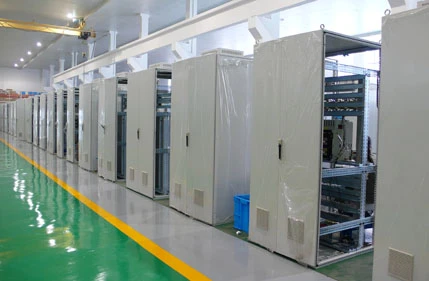AGC System
The Automatic Gauge Control System (AGC) is an advanced, precision-driven solution designed to optimize and maintain consistent material thickness during manufacturing processes, particularly in industries such as steel, aluminum, and paper production. This system uses sophisticated sensors and automated feedback mechanisms to continuously monitor and adjust the thickness of the material being processed, ensuring it meets the required specifications without the need for manual intervention. By integrating real-time data from various measurement points, the AGC system offers precise control, reducing variability and enhancing product quality. It is equipped with advanced algorithms that dynamically adjust the gauge control rolls or other processing equipment to correct any discrepancies immediately, ensuring uniformity and reducing waste. The system is highly adaptable, compatible with both existing and new production lines, and can handle a wide range of materials, including metals, plastics, and composite materials. Additionally, the AGC offers significant improvements in operational efficiency by reducing downtime, enhancing throughput, and lowering the need for manual inspections or adjustments, thus contributing to overall cost savings. With its robust reliability, the Automatic Gauge Control System is an essential tool for manufacturers looking to achieve high-precision control over material processing and to maintain the highest standards of production.
How Automatic Gauge Control Systems Improve Manufacturing Precision and Efficiency
Automatic Gauge Control (AGC) systems have become a vital part of modern manufacturing, particularly in industries like steel, aluminum, and paper production. These systems are designed to ensure consistent material thickness, a critical factor in maintaining product quality and optimizing production processes. By offering precise, real-time measurements and adjustments, AGC systems significantly enhance both the precision and efficiency of manufacturing operations.
One of the key advantages of AGC systems is their ability to maintain uniform material thickness throughout the production process. Traditional methods of thickness measurement often rely on manual checks or mechanical adjustments, which can lead to inconsistencies. In contrast, AGC systems use advanced sensors to continuously monitor material thickness, making automatic adjustments to processing equipment as needed. This automated feedback loop helps prevent variations that could result in defects, reducing scrap and waste.
In terms of efficiency, AGC systems minimize downtime by eliminating the need for manual interventions. With real-time data and automated adjustments, production lines can run without interruption, allowing manufacturers to achieve higher throughput and maintain steady production rates. Furthermore, the system reduces the frequency of rework and corrective actions, which can be time-consuming and costly.
Additionally, AGC systems contribute to sustainability by reducing material waste. By ensuring the material is consistently at the desired thickness, manufacturers can make the most efficient use of raw materials, minimizing excess and scrap. This not only reduces costs but also lessens the environmental impact of the manufacturing process.
The Role of AGC Systems in Reducing Material Waste in Production Lines
Automatic Gauge Control (AGC) systems are transforming manufacturing by significantly reducing material waste on production lines. As industries strive for greater efficiency and sustainability, AGC systems provide a critical solution to optimize the use of raw materials, ensuring they are processed with maximum precision.
At the heart of AGC systems is their ability to maintain consistent material thickness throughout production. In industries like steel, aluminum, and paper manufacturing, variations in material thickness can lead to defects, requiring rework or even scrapping entire batches. Traditional methods, which often rely on manual measurements or mechanical adjustments, can cause errors that result in uneven thickness and wasted resources. AGC systems, however, use advanced sensors and real-time feedback mechanisms to automatically monitor and adjust material thickness with high accuracy. This constant adjustment ensures that the material meets the required specifications without unnecessary over-processing.
By ensuring that material thickness remains consistent, AGC systems prevent excess material from being used or discarded. For example, when material is too thick or too thin, it may need to be scrapped, leading to both financial losses and environmental impact. With AGC, any discrepancies are corrected in real-time, reducing scrap and rework. The result is more efficient use of raw materials and a reduction in overall material consumption.
Moreover, AGC systems contribute to sustainability goals by minimizing waste and supporting cost-effective manufacturing practices. With less scrap, manufacturers can reduce production costs and lower their environmental footprint, contributing to more sustainable operations.




